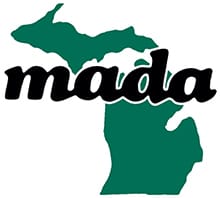You may have begun to notice a new style of left-turn signal on Michigan’s roads. Placed OVER the left-turn lane at a signalized intersection, this new signal display includes a flashing yellow arrow. In coming years, this type of signal will replace all flashing red left-turn signals.
How will it work?
In most locations, the flashing yellow arrow will be part of a four-arrow signal. In areas where this is not possible, the bottom of a three-arrow signal will display either the flashing yellow arrow or a steady green arrow.
Signal phases:
| Red: STOP. | |
| Flashing yellow arrow: Left turns permitted. Yield to oncoming traffic and pedestrians. [Oncoming traffic has a green light.] | |
| Green arrow: Safe to turn left. [Oncoming traffic must stop.] | |
| Steady yellow arrow: The left-turn signal is about to change to red; prepare to stop, or prepare to complete your left turn if you are within the intersection. |
Why the change?
This change is the result of a national study conducted for the Federal Highway Administration, which demonstrated that the new signals:
- help to prevent crashes
- move more traffic through an intersection
- and provide additional traffic management flexibility.
Why is it a better left-turn signal?
- It’s safer. A national study demonstrated that drivers made fewer mistakes with the new signals than with traditional left-turn arrow signals.
- It’s more efficient The new signals provide traffic engineers with more options to handle variable traffic volumes.
- It’s more consistent. You’ll see the same signals in every state because the new signals are being introduced throughout the U.S.


